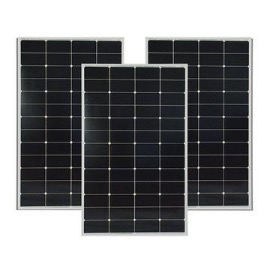I. Core components: solar cells
l Working principle: Based on the photovoltaic effect, semiconductor materials (such as silicon) absorb the energy of sunlight photons to generate electron-hole pairs, which are separated to form current under the action of the built-in electric field of the PN junction.
l Mainstream types:
a) Monocrystalline silicon cells: high efficiency (about 18%-25%), high cost, good stability.
b) Polycrystalline silicon cells: medium efficiency (about 15%-20%), low cost, and wide application.
c) Thin film cells: such as cadmium telluride (CdTe), copper indium gallium selenide (CIGS), etc., low cost, good flexibility, but low efficiency (about 10%-18%), suitable for specific scenarios (such as building integration).
II. System composition
l Photovoltaic array: composed of multiple solar modules connected in series/parallel, it is the core part of power generation.
l Inverter: Converts the direct current (DC) generated by the battery into alternating current (AC) to meet the needs of the power grid or load, and is divided into centralized, string, micro inverter, etc.
l Energy storage system (optional): such as lithium batteries, used to store excess electricity and solve the intermittent problem of photovoltaic power generation.
l Bracket and tracking system:
a) Bracket: Fixed photovoltaic modules, need to consider load-bearing, wind resistance, inclination (optimize light reception according to latitude).
b) Tracking system: divided into single-axis (tracking the solar azimuth) and dual-axis (tracking azimuth + altitude), which can increase power generation by 10%-30%, but the cost is relatively high.
l Combiner box and distribution cabinet: The combiner box concentrates the current of multiple components, and the distribution cabinet is responsible for circuit protection and distribution of electric energy.
III. Key technical indicators
l Conversion efficiency: The proportion of solar energy converted into electrical energy by the battery is the core indicator for measuring performance, which is affected by materials, temperature, and light intensity.
l Temperature coefficient: The extent to which efficiency decreases when the temperature rises. The smaller the coefficient, the more stable the performance at high temperature.
l Power generation: Affected by component efficiency, light resources (irradiance), system losses (such as inverter efficiency, cable losses), etc.
IV. Key points of system design
l Site selection and light assessment: Prioritize areas with sufficient light (high annual irradiance) and less obstruction, and consider the impact of shadows (such as trees and buildings) on power generation.
l Component layout: Reasonably design the spacing to avoid mutual obstruction between components (especially in winter when the solar altitude angle is low).
l Grid-connected and off-grid design:
a) Grid-connected system: directly connected to the grid, no energy storage (or equipped with a small amount of energy storage), must comply with grid specifications (such as voltage and frequency matching).
b) Off-grid system: independent operation, relying on energy storage equipment, and the energy storage capacity and photovoltaic installed capacity must be calculated according to load demand.
V. Operation and life
l Daily maintenance: regularly clean components (reduce dust obstruction), check circuit connections (avoid loss caused by poor contact), and monitor inverter status.
l Life: The life of Solar Module components is usually 25-30 years, and the life of inverters is about 10-15 years. They need to be replaced regularly to ensure system efficiency.

Join the Sun-Earth Family Today
If you are looking for high-quality solar panels that deliver exceptional performance, durability, and value for money, Sun Earth Solar is the right choice. With our extensive product line, commitment to sustainability, and exceptional customer service, Ningbo Sun Earth are the ideal partner for all your solar needs.
Contact us today to learn more about our solar panel solutions and how we can help you get the most out of the sun. Together, Sun earth can achieve extraordinary things and create a brighter, more sustainable future for ourselves and our children.
Keywords:
Sun Earth Solar, Ningbo Sun Earth, Sun-Earth, Sun Earth, Solar Panel,Solar Module, Photovoltaic system


